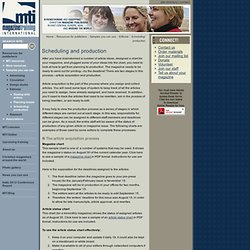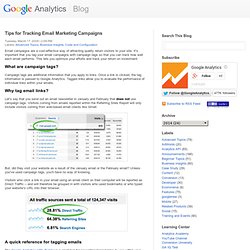

Scheduling and production. After you have brainstormed a number of article ideas, designed a chart for your magazine, and plugged some of your ideas into the chart, you need to look at how to get from planning to production.

The magazine needs to be ready to send out for printing—by the deadline! There are two stages in this process—article acquisition and production. Article acquisition is the part of the process where you assign and collect articles. You will need some type of system to keep track of all the articles you need to assign, have already assigned, and have received. In addition, you’ll need to track the articles that need to be rewritten, are in the process of being rewritten, or are ready to edit. It may help to view the production process as a series of stages in which different steps are carried out at each stage.
Magazine chart This sample chart is one of a number of systems that may be used. Here is the supposition for the deadlines assigned to the articles: How to use a production chart: The CAN-SPAM Act: A Compliance Guide for Business. Do you use email in your business?

The CAN-SPAM Act, a law that sets the rules for commercial email, establishes requirements for commercial messages, gives recipients the right to have you stop emailing them, and spells out tough penalties for violations. Despite its name, the CAN-SPAM Act doesn’t apply just to bulk email. It covers all commercial messages, which the law defines as “any electronic mail message the primary purpose of which is the commercial advertisement or promotion of a commercial product or service,” including email that promotes content on commercial websites. The law makes no exception for business-to-business email. That means all email – for example, a message to former customers announcing a new product line – must comply with the law. Each separate email in violation of the CAN-SPAM Act is subject to penalties of up to $16,000, so non-compliance can be costly.
Don’t use false or misleading header information. Need more information? Q. A. Q. A. Q. Tips for Tracking Email Marketing Campaigns. Email campaigns are a cost-effective way of attracting quality return visitors to your site.

It's important that you tag your email campaigns with campaign tags so that you can track how well each email performs. This lets you optimize your efforts and track your return on investment. What are campaign tags? Campaign tags are additional information that you apply to links. Once a link is clicked, the tag information is passed to Google Analytics. Why tag email links? Let's say that you send out an email newsletter in January and February that does not use campaign tags.
But, did they visit your website as a result of the January email or the February email? Visitors who click a link in your email using an email client on their computer will be reported as Direct Traffic -- and will therefore be grouped in with visitors who used bookmarks or who typed your website's URL into their browser. A quick reference for tagging emails Making Life Easier That's all!